Hosta Growers And Society Members Share Their Secrets Learned Over Many Years

PERENNIALS > HOSTA
Reviewed By COLIN SKELLY

Colin is a Horticulturist and Horticultural Consultant with experience in a range of practical and managerial roles across heritage, commercial and public horticulture. He holds the Royal Horticultural Society’s Master of Horticulture award and has a particular interest in horticultural ecology and naturalistic planting for habitat and climate resilience.
Contributions From JOHN PLANT

With 50 years of experience in the landscaping business, John has been growing and selling hostas for 15 years and is the owner of specialist nursery Rewela Hostas. Based in Yorkshire, he has his own YouTube channel where he shares plant care and growing tips.

An RHS gold-medalist, recently winning two golds at the Chelsea Flower Show in 2021 and 2022, Ollie is the Nursery Manager at Sienna Hostas. Ollie is also a member of The British Hosta and Hemerocallis Society.

Owner of plant nursery North Staffordshire Hostas, Robert is also a member of The British Hosta and Hemerocallis Society and is one of their featured suppliers. Robert is also a member of the Plant Heritage Society and has his own national collection of hostas that is available to the public to view with pre-booked appointments.

Mickfield Hostas is home to the largest National Collection of British Hostas in the UK, according to Plant Heritage. Melanie is a Partner at this specialist plant nursery, which won 7 RHS gold medals at flower shows in 2016 alone. She has her own YouTube channel where she shares updates from the nursery.

Barry is the membership secretary from the American Hosta Society. He is a retired owner of a specialist hosta nursery based in Illinois with over 40 years of growing experience.

The President of the Delaware Valley Hosta Society, David has been a member of this society for almost 30 years and is also a member of the American Hosta Society. David is based in the US and shares videos about Hostas on his YouTube channel.

Sue is the Owner of Sue Proctor Plants, a specialist Hosta nursery based in West Yorkshire. She has been growing Hostas for over 50 years and miniature varieties for over 20 years. She runs her nursery with her husband Richard.

Sally Flatman is the host and creator of the 'Our Plant Stories' podcast. She is a former BBC Radio producer and has received an RHS Level 2 Certificate in the Principles of Horticulture from Capel Manor College.
HOSTA GUIDES
Super-hardy hostas are a foliage favourite, especially for shady spots.
These deciduous perennials are valued for their fascinating foliage, as their leaves may be wavy, bowl-shaped, puckered or ridged.
Though their colours include a proper rich ‘leafy green’, they also include creams and yellows, and greyish-bluish green.
Many are edged or bordered while others undergo colour changes as the season progresses.
If you go for fascinating foliage, have a shady garden, also have heavy soil, and like low-care perennials, hostas are made for you.
In this guide, we’ve collaborated with SEVEN hosta specialists, including:
- John Plant – Owner of specialist nursery Rewela Hostas.
- Ollie Walker – Nursery Manager at Sienna Hostas.
- Robert Barlow – Owner of plant nursery North Staffordshire Hostas.
- Melanie Collins – Partner at Mickfield Hostas.
- Barry Ankney – Membership Secretary for the American Hosta Society.
- David Teager – President of the Delaware Valley Hosta Society.
- Sue Proctor – Owner of specialist nursery Sue Proctor Plants.
“Hostas are incredibly diverse in size, leaf shape, colouration, and texture,” says Barry.
“Some Hostas grow in mounded shapes, while others are upright vase-shaped plants. Hostas range in size from 5-125cm high.
“Leaf shapes vary from slender lance-shaped leaves to those that are more rounded. They can be green, yellow, blue, or a combination of those colours and may have variegated edges or display variegation at their centre.”
Overview
| Botanical Name | Hosta |
| Common Name(s) | Plantain Lily |
| Plant Type | Perennial |
| Native Area | China, Japan, North & South Korea |
| Hardiness Rating | H7 |
| Foliage | Deciduous |
| Flowers | Mainly bell-shaped |
| When To Plant | March-May and September-November |
| When To Prune | December |
Sunlight
Preferred
Dappled Shade
Exposure
Sheltered
Size
Height
0.1 – 0.75M
Spread
0.1 – 1.5M
Bloom Time
Summer
Soil
Preferred
Clay
Moisture
Moist
pH
Acidic to neutral
In their native Japan and the Far East, these plants are called Giboshi, but are more commonly known as the Plantain Lily.1Hosta Collecting in Japan. (n.d.). Hosta Library. Retrieved March 17, 2023, from https://www.hostalibrary.org/articles/Japan.htm
They do share one attribute, though: almost all popular varieties are clump-forming and, therefore, gradually keep spreading.
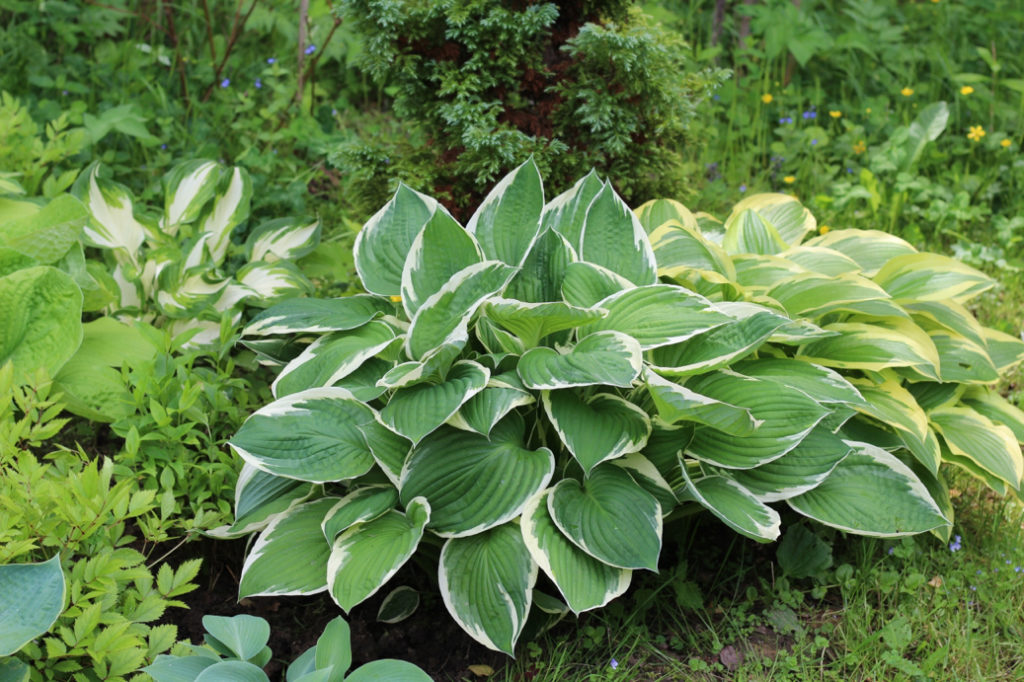
The foliage interest of these plants is amazingly diverse and most gardeners consider the flowers a side attraction or a bonus.
“We love growing hostas because they provide colour in the garden all season, from late Spring until the Autumn when they die down, ready to reappear the following year,” says Sue.
For several weeks in summer, flowers, usually bell-shaped, are borne in clusters, usually in shades of purple and white.
Hostas are vigorous, long-lived plants, explains John Plant, the owner of Rewela hostas, with over 15 years of experience:
“There are very few that offer the range of colour, and size of leaves than Hostas. They offer you at least 6 months of interest in the garden each year.
“They then go to sleep, but always come up again next year without further cost or care.”
Once they’re all set in favourable locations, they will need minimal maintenance while making a rich return of many years of top-notch decorative foliage.
Choosing Types
“I personally prefer plain-leaved cultivars with interesting habits, like Cutting Edge and Niagara Falls,” says Melanie.
“The leaves droop downwards on Niagara Falls and have a piecrust rippled margin.
“I love natural-looking garden spaces rather than too much colour, so I love hostas that add to that type of environment rather than clash.
“Although I can admire variegated hostas, I am less keen on the brightly variegated cultivars as they can look rather false in a natural setting and look much better as specimens in containers.”
Despite Melanie’s preference for plain cultivars, we have put together some of our favourite varieties of hostas which do include brighter cultivars too.
How To Grow Hostas
Where To Plant
“Contrary to popular belief, hostas like more light and less water than most people think,” says Ollie Walker, the nursery manager at Sienna Hostas.
“A very dark, wet spot in the garden is actually as bad as a dry and sunny spot. Ideally dappled shade or morning/afternoon sun in moist, free-draining soil is perfect.”
Hostas are classic shade garden plants and can be planted in beds or used for garden borders.
However, it’s good to keep in mind that they boast an enormous range in height.
The smaller varieties are perfect for front borders while the taller ones are just as perfect for the rear and as backdrops.
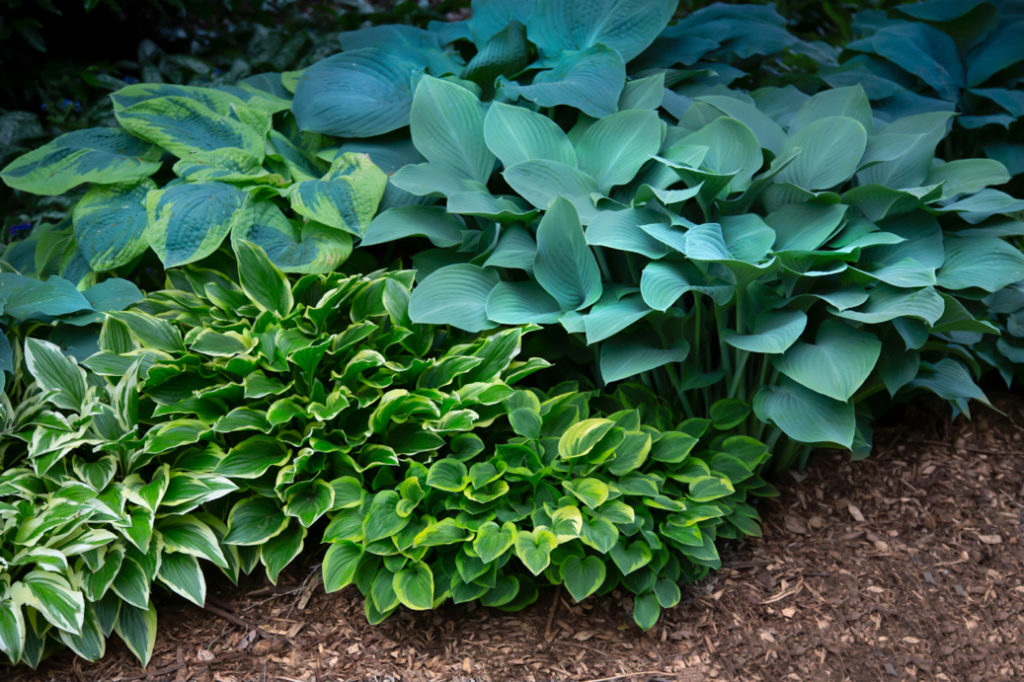
The intermediate height varieties are great for interspersing between flowering plants in a bed or placing in a dedicated shrubbery corner.
Miniature varieties make for delightful edging and are just brilliant for rockeries.
All hostas plants are very amenable to being planted in pots and containers.
When To Plant
Though Hostas are tough plants and can be planted at any time of the year, I’d recommend planting them in spring or autumn.
How To Plant
Hostas are normally bought as potted plants or acquired as bare-root divisions from a clump, and it is in one of these forms that you would be planting a hosta.
The planting hole should be about as deep as the rootball but twice its width.

Ensure that the plant is not root-bound; if it is, spread out the roots.
Place the plant in the hole and backfill it promptly, ensuring that the soil line is the same as it was in the pot.
Pat down the soil all around and water well.
Hosta Plant Care
Hostas are notorious for being easy to grow.
Once they are planted in the right spot they will thrive for years without any particular care.
Precise instructions on how to grow these plants are given underneath.
Light
In general, partial shade is very suitable for hostas and they even do quite well in full shade.
That said, the ideal type of light for these plants is dappled or filtered sunlight for a few hours a day, as David explains:
“While some think of them as shade-loving, they are merely shade tolerant and perform best with some sun, the amount strongly dependent upon their need for water and protection from the hottest sun.”
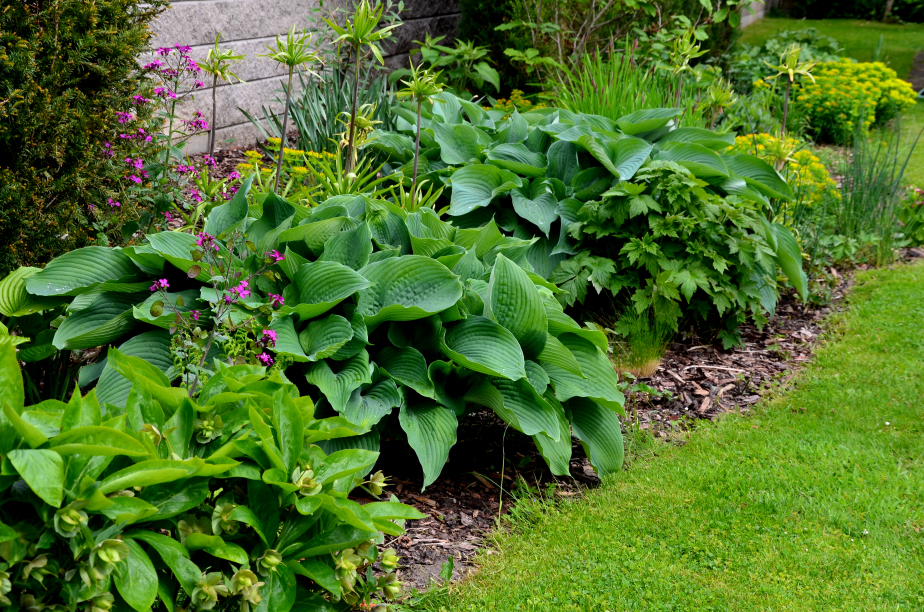
Sun-shade preferences vary by cultivar.
“Hostas are shade-tolerant plants, but they still require some sunlight, the amount of sunlight largely depends on their colour, which generally relates to the number of chloroplasts in the plant,” explains Barry.
“Blue hostas appear blue because of a wax coating on the leaf. If this wax coating is rubbed off, or burned off by the sun, the leaf looks green.
“When caring for hostas with blue colouration, it is important to know that too much direct sunlight will burn away the waxy coating on the leaf that makes the leaf appear blue.
“It is best to grow blue hostas in a location where they get some early morning sun followed by a day in the shade.”
As a rule, the more yellow the foliage, the more sunlight the plant should get and the more bluish the foliage, the less sun it should get.
Soil
Hostas generally need a heavyish, rich soil says Robert Barlow, a hosta enthusiast from North Staffordshire Hostas.
“Hostas like moisture-retentive soils that are slightly acidic. They do not, however, like to be submerged in water for any length of time.”
A mixed loam of sand, chalk and clay tilled to about 15cm deep and amended generously with organic compost or well-rotted organic manure will suit them perfectly.
These plants prefer moist soil.
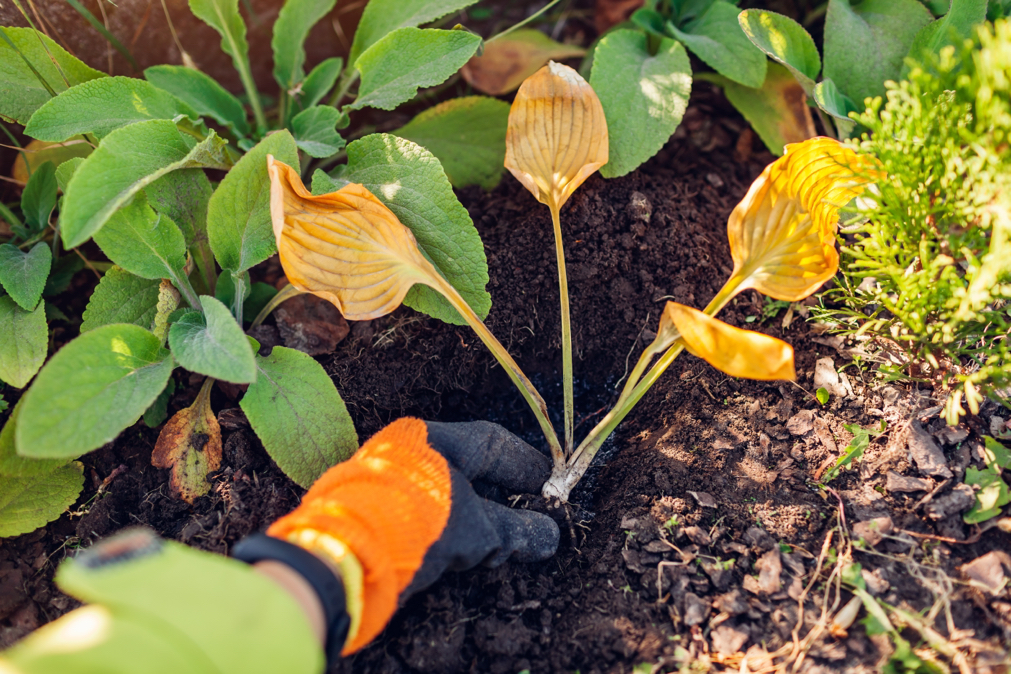
If the soil has insufficient clay then some vermiculite should be added to the soil or a layer of organic mulch may be laid to increase moisture retention.
Slightly acidic to neutral soil pH works best for these plants.
Watering
“The single most important thing about successfully growing Hostas is knowing that they love water,” says Barry.
“Hostas require at least 2.5cm of water per week to thrive. Hostas will survive with less water, but if you want your plants to thrive, give them plenty of it.”
Although their water needs may partially be met by rainfall, watering will usually be required.
“Don’t give them a sprinkle of water daily, water once a week during the season and water well,” suggests Melanie.
Temperature & Humidity
Hostas do not have any particular temperature or humidity requirements, and any given variety should be perfectly comfortable with the temperature and humidity throughout the UK.
“Hostas are excellent garden plants that can grow in many garden conditions in climates with winter cold,” says David Teager.
“Not merely single-season perennials, they are most beautiful from the time they emerge until the first killing frost.”
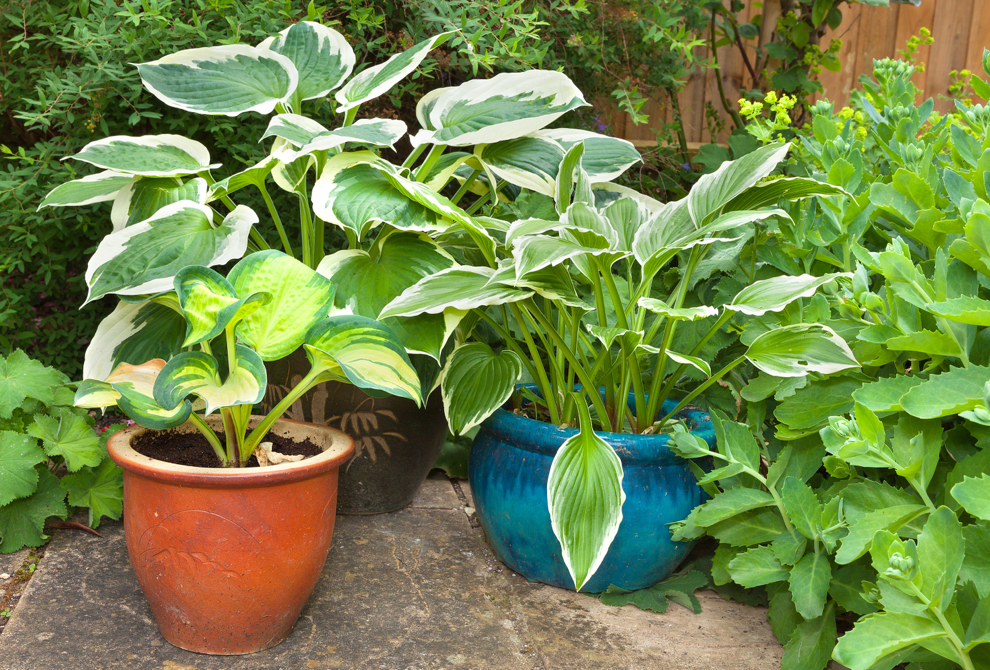
“Although hardy in the UK climate, hosta leaves emerging in spring may get damaged by frost,” adds Horticulturist Colin Skelly.
“Protect by adding a layer or two of fleece if frost is forecast.”
Fertilising
As long as hostas are rooted in rich, fertile soil, they do not need fertilising.
A mulch of organic compost about once a year will be quite sufficient.
Otherwise, you can use an organic balanced fertiliser, diluted as appropriate, once each spring.
“Don’t be tempted to overfeed your hostas,” says Melanie.
“It may help produce extra foliage but often this is at the expense of the plant’s characteristics. Seaweed extracts or tomato feed is good a couple of times a year.”
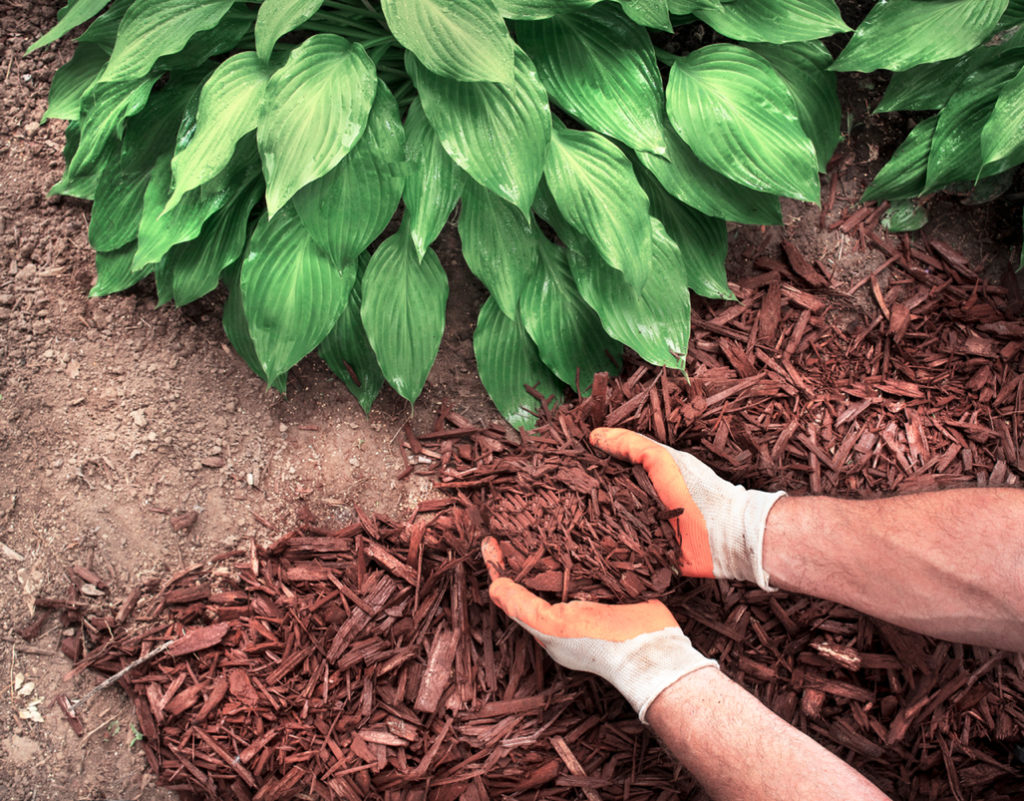
Hostas in containers should be fertilised more often to ensure attractive foliage.
For these, apply a balanced liquid fertiliser about every four weeks during spring and summer.
“I use a nitrogen liquid feed or pelleted chicken manure,” says Robert, from North Staffordshire Hostas.
“Feed your hosta plants a maximum of 3-4 times a year from April. Don’t feed your hostas after July.”
Common Problems
Generally, hostas are pest-resistant and disease-free plants.
Occasionally may they succumb to vine weevil, but this only usually affects potted hostas.
“Vine weevils can sometimes be a problem,” shares Sue Proctor.
“Adult weevils feed on the edges of leaves and the small notches they cut out of leaf edges are unmistakable.
“I use vine weevil nematodes in September and April, concentrating on those areas where there are attacks.”
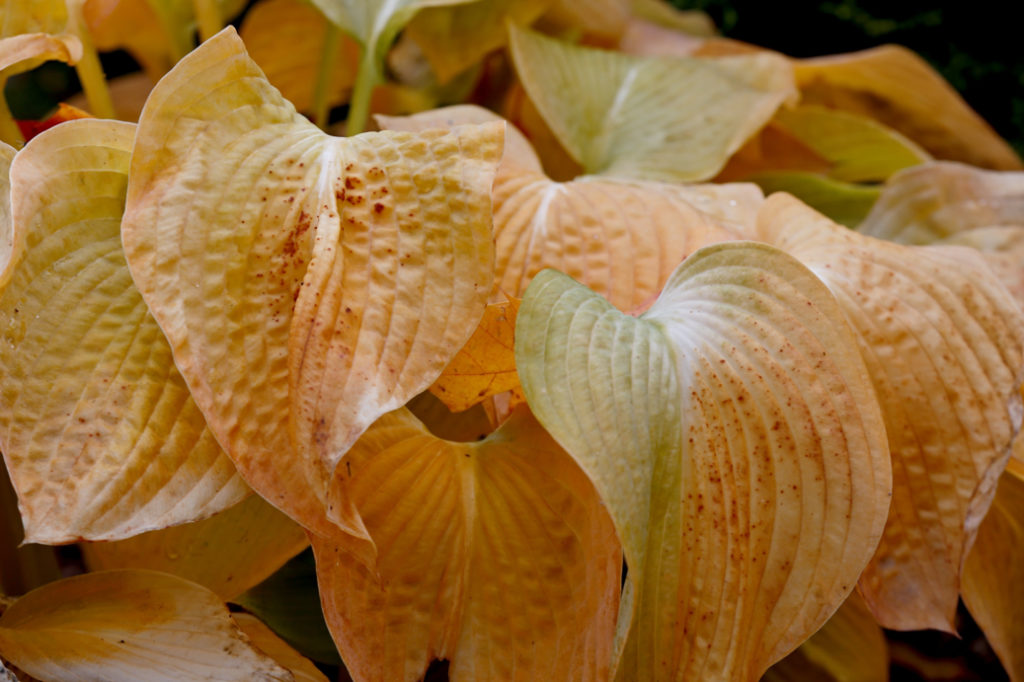
A more serious problem that hostas might face is Hosta Virus X (HVX).
To escape this, David Teager suggests that you: make sure to buy hostas from reputable dealers (or shared by knowledgeable friends), and closely observe and handle any new acquisitions to catch any disease before it spreads.
Unfortunately, hostas are almost sure to be targeted and chomped on by slugs and snails.
Not only does this degrade the aesthetic appeal of the plants, slugs and snails sometimes destroy the foliage to such an extent that young, small, or weak plants die.
“The most obvious problem, which everyone lights on, is slugs and snails, as there is nothing more infuriating than having your perfect hosta leaves munched on,” says Melanie.
How To Stop Slugs Eating Hostas
Slugs have nocturnal habits; they chew up plants in the dead of night and remain out of sight during the day.
Therefore, it is difficult to directly eliminate these pests.
Even if they were diurnal, slugs are so icky that you may not want to pick them or squash them!
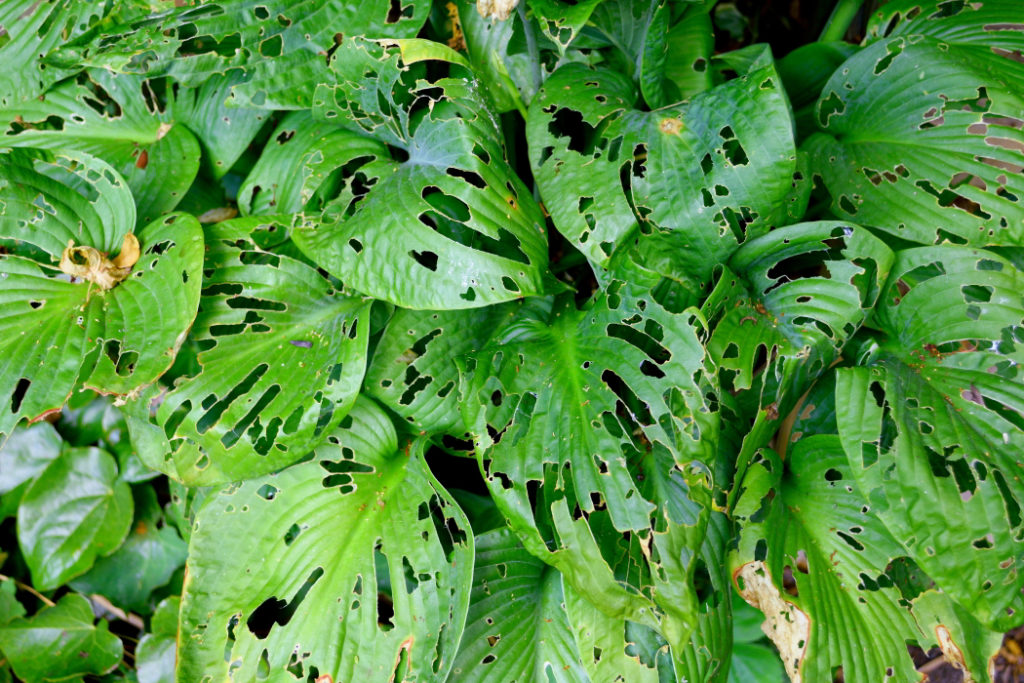
“Barriers and beer traps both work well for trapping slugs and snails, but if your garden is overrun, you first need to reduce numbers by going out after dark with a torch to find, catch and dispose of the critters,” says Sue.
“A squirt of household ammonia diluted 1:10 with water will kill slugs almost instantly and is more humane than using a pinch of salt.”
Another tried-and-trusted method is to put copper strips or copper tape around the plants.
A slug’s own slime reacts with copper to give a mild shock to the pest.
This method will only protect your plants but will not kill the slugs.
Another method is to use a garlic wash, which is a method recommended by the growers from both Rewela Hostas and Sienna Hostas.
“A garlic wash is really easy to make,” says Ollie.
“Boil 2 full bulbs of garlic in 2L of water until soft, then sieve out the bits to reveal your concentrate.
“Dilute 2 tablespoons of this, then water and spray over the top of your plants once a week.”
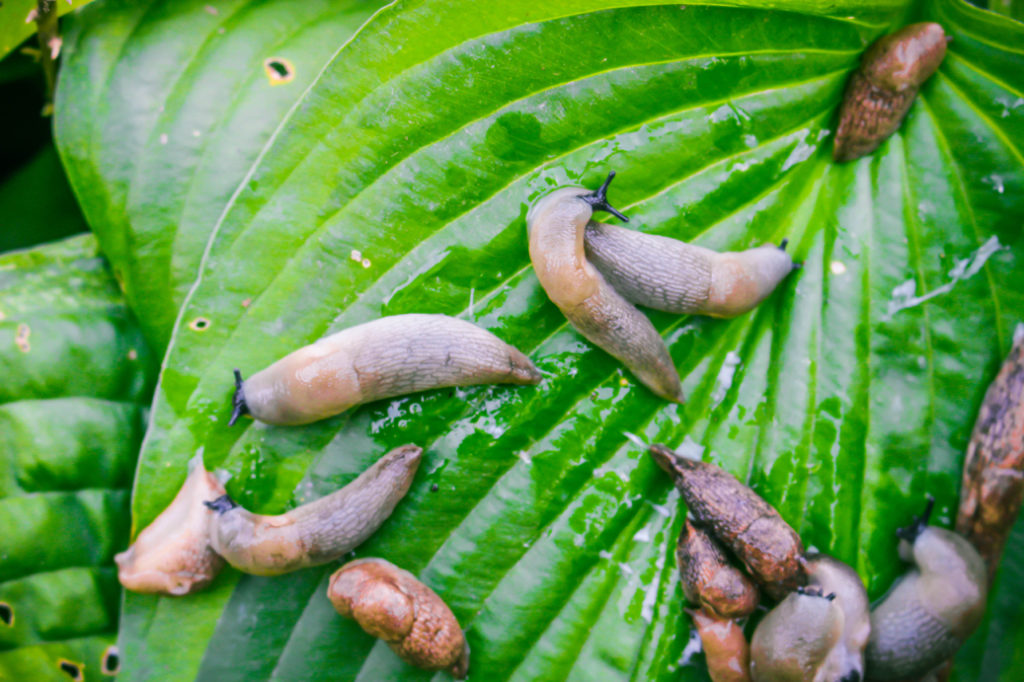
“My hostas used to get eaten to bits until I was introduced to a garlic wash,” shares Gardener Sally Flatman.
“I used that religiously last year and now my hostas are completely changed plants!”
Alternatively, you could place purpose-built types of nooks or crannies that slugs like to get in or under close to your chewed-up hostas.
You can do so using flat rocks, small slabs, or wooden boards.
Get out in the early part of the morning to look under them for the pests, and when seen you can get rid of them easily.
References
- 1Hosta Collecting in Japan. (n.d.). Hosta Library. Retrieved March 17, 2023, from https://www.hostalibrary.org/articles/Japan.htm

